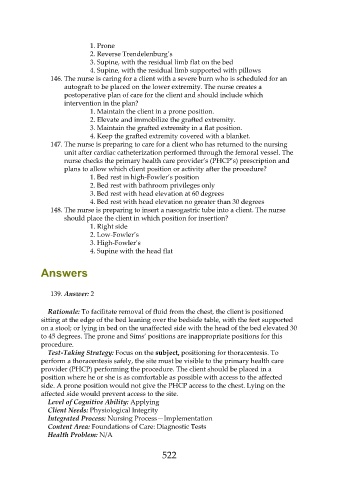Page 522 - Saunders Comprehensive Review For NCLEX-RN
P. 522
1. Prone
2. Reverse Trendelenburg’s
3. Supine, with the residual limb flat on the bed
4. Supine, with the residual limb supported with pillows
146. The nurse is caring for a client with a severe burn who is scheduled for an
autograft to be placed on the lower extremity. The nurse creates a
postoperative plan of care for the client and should include which
intervention in the plan?
1. Maintain the client in a prone position.
2. Elevate and immobilize the grafted extremity.
3. Maintain the grafted extremity in a flat position.
4. Keep the grafted extremity covered with a blanket.
147. The nurse is preparing to care for a client who has returned to the nursing
unit after cardiac catheterization performed through the femoral vessel. The
nurse checks the primary health care provider’s (PHCP’s) prescription and
plans to allow which client position or activity after the procedure?
1. Bed rest in high-Fowler’s position
2. Bed rest with bathroom privileges only
3. Bed rest with head elevation at 60 degrees
4. Bed rest with head elevation no greater than 30 degrees
148. The nurse is preparing to insert a nasogastric tube into a client. The nurse
should place the client in which position for insertion?
1. Right side
2. Low-Fowler’s
3. High-Fowler’s
4. Supine with the head flat
Answers
139. Answer: 2
Rationale: To facilitate removal of fluid from the chest, the client is positioned
sitting at the edge of the bed leaning over the bedside table, with the feet supported
on a stool; or lying in bed on the unaffected side with the head of the bed elevated 30
to 45 degrees. The prone and Sims’ positions are inappropriate positions for this
procedure.
Test-Taking Strategy: Focus on the subject, positioning for thoracentesis. To
perform a thoracentesis safely, the site must be visible to the primary health care
provider (PHCP) performing the procedure. The client should be placed in a
position where he or she is as comfortable as possible with access to the affected
side. A prone position would not give the PHCP access to the chest. Lying on the
affected side would prevent access to the site.
Level of Cognitive Ability: Applying
Client Needs: Physiological Integrity
Integrated Process: Nursing Process—Implementation
Content Area: Foundations of Care: Diagnostic Tests
Health Problem: N/A
522

